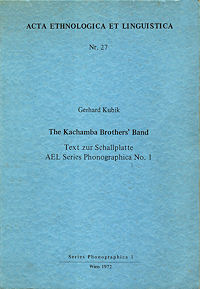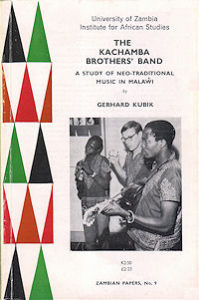| Botswana | Lesotho | Malaŵi | Moçambique | Namibia | South Africa | Swaziland | Zambia | Zimbabwe |
> Malaŵi | Books | Articles |

See as well / Voir aussi / Veja também “Africa general – Books”
Fenn III, John Bennett:
Rap and Ragga Musical Cultures, Lifestyles, and Performances in Malawi.
Ph.D. Indiana University (Bloomington, Ind.), 2004. vi & 246 p.
ProQuest no. 3133970
Deja, Richard Michael:
From Place to Placelessness: Malawian Musicians,
Commercial Music, and Social Worlds in Southern Africa.
Ph.D. University of Illinois at Urbana-Champaign, 2016. iv & 246 p.
Contents – PDF Download / Télécharger / Baixar 61.60 MB
Koma-Koma, W. P.:
M’ganda kapena malipenga.
Limbe: Malawi Publications and Litterature Bureau, 1965.
Kubik, Gerhard:
The Kachamba Brother’s Band.
Text zur Schallplatte AEL Series Phonographica No. 1.
Acta Ethnologica et Linguistica (Wien), Nr. 27, Series Phonographica No. 1, 1972. 80 p.
Inhalt
English edition
The Kachamba Brother’s Band
A Study of Neo-Traditional Music in Malawi.
Lusaka: University of Zambia/ Manchester: Oxford University Press, Zambian Papers No. 9, 1974. 75 p.
Contents
Malamusi, Moya Aliya:
Endangered Traditions – Endangered Creativity.
Ndano, Ngoli, Chitata, Pango, Alimba, Ingoma, Likhuba,
Nyimbo za pa mtondo, Guitar, Ulimba, Gule wa Chimang’anja, Nkangala.
Frankfurt: Popular African Music PAMCWM 801, 2011. 35 p. audio CD & DVD
Malamusi, Moya Aliya:
The Banjo Bands of Malawi.
Stefan Grossman’s Guitar Workshop (Sparta, N.J.), 2015.
Item Number: Vestapol 13135 – DVD (78 minutes) with PDF booklet.
Seebode, Jochen:
Jugend, Musik und Tanz in Post-Banda-Malawi (1994-2004).
Männliche Jugendliche in Chitipa und Karonga.
Ph.D. Freie Universität Berlin, 2009. 409 p.
Inhalt – PDF Download / Télécharger / Baixar 10.21 MB
Page created 29/09/2017 © afrobib.com – update 26/10/2018

 CONTENTS
CONTENTS INHALT (Button Type)
INHALT (Button Type) CONTENTS
CONTENTS INHALT
INHALT
 CONTENTS
CONTENTS CONTENTS
CONTENTS INHALT (Button Type)
INHALT (Button Type) CONTENTS
CONTENTS